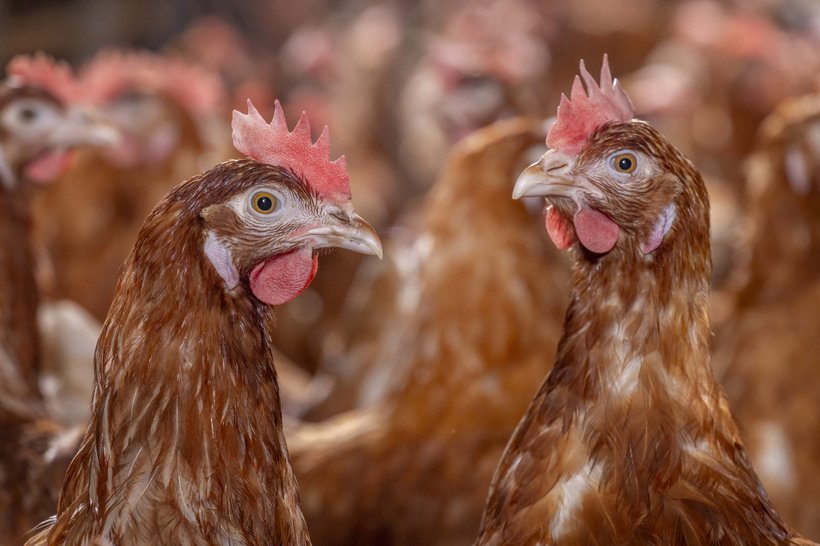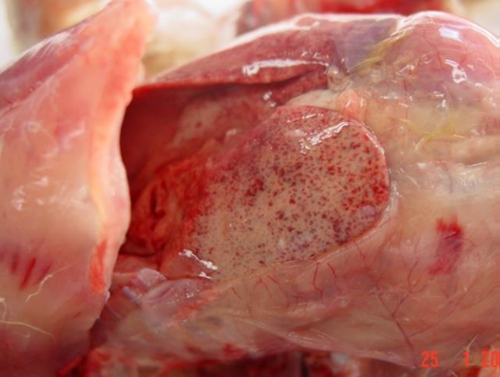
Published on Dec. 4, 2024
Fowl Adenovirus
Infections by Fowl Adenovirus are widespread and endemic worldwide. These viruses are known from the middle of the last century, but they have gained attention recently due to rising awareness of their spread and increased incidence of associated diseases: these days it is considered an emerging disease specially in some areas of the world like North and South America and Asia.
Most FAdV does not cause disease, only certain serotypes are associated with pathological conditions in chicken, mostly in broiler and broiler breeders. This means that FAdV and/or their antibodies can be frequently found in healthy birds without any clinical sign of disease. Anyway, some serotypes have a primary role in three well-characterized syndromes: Inclusion Body Hepatitis (IBH), Hydropericardium Syndrome (HPS also known as Angara Disease) and Adenoviral Gizzard Erosions (AGE). These syndromes are very rare in layers or layer breeders and there are very few well-documented cases worldwide.
Etiology and epidemiology
Avian adenovirus are classified in three groups:
- Group 1 (Aviadenovirus): the most common in poultry, including FAdV responsible of inducing the three afore mentioned syndromes, mostly in broilers.
- Group 2 (Siadenovirus): includes viruses causing disease in turkeys (Hemorrhagic Enteritis) and pheasants (Marble Spleen Disease).
- Group 3 (Atadenovirus): contains a virus producing a disease of significance in layers, Egg Drop Syndrome (EDS 76).
FAdv are classified into five species (from A to E) and there are 12 different serotypes described. Only a few of them have been associated so far to diseases in poultry:
- Serotype 1, from group A
- Serotype 4, from group C
- Serotypes 2 and 11, belonging to group D
- Serotypes 8a and 8b, from group E
These serotypes differ in pathogenicity: 4 and 8b are highly pathogenic, while 2 and 11 are less pathogenic.
Clinical signs and lesions of diseases associated to FAdV
Inclusion Body Hepatitis is caused by FAdV belonging mainly to serotypes 2, 4, 8a, 8b and 11. The condition affects broiler and broiler breeders, showing increased mortality and clinical disease mostly between 2 – 3 weeks of age, although it can be seen from 4 days to 7 weeks of age.
Affected birds are lethargic, with ruffled feathers and have a distended belly. Droppings have a yellow mucoid aspect. Occasionally neurological signs can appear. Weight gain is reduced.
Mortality peaks after 3-4 days and then decreases over the following 9 -14 days. Final mortality ranges usually between 2-10% but can attain up to 30% depending on pathogenicity of the virus, immune status or secondary infections.
Main macroscopic lesions are:
- Enlarged liver, pale and friable, frequently with necrotic or hemorrhagic foci;
- Hemorrhages can also be observed in leg or breast muscles in cases of co-infection with CAV;
- Severe inflammation of kidneys, pale and with hemorrhagic foci;
- Ascites;
- Sometimes hydropericardium;
- Most dead birds have an enlarged spleen and atrophy of the thymus;
- Anemia, icteric skin and subcutaneous fat, hemorrhages in different organs, altered bone marrow.
Most typical histopathologic lesions are found in the liver:
- Hepatocytic degeneration;
- Coagulative necrosis;
- Basophilic intranuclear inclusion bodies.

Inclusion Body Hepatitis: enlarged liver with hemorrhagic foci. Source: Dra. Natalia Majó, IRTA
Hydropericardium Syndrome (HPS) is mostly linked to FAdV serotype 4.
Clinical signs are non-specific and similar to IBH: lethargy, ruffled feathers etc.
Onset of mortality is abrupt and usually higher than IBH, reaching up to 75 % in broilers, but age tends to be later than in IBH, from 3 to 5 weeks of age.
HPS is mainly caused by horizontal infection associated with immunosuppression, co-infection with other virus (CAV, IBD) or mycotoxins.
Macroscopic lesions are similar to those observed in IBH, but in general there is higher incidence of hydropericardium with higher content of fluid in the pericardial sac. Other possible lesions are:
- Thymus atrophy;
- Myocardial edema and necrosis;
- Liver congestion with inclusion bodies.
Adenoviral Gizzard Erosions are mainly caused by FAdV serotype 1.
Clinical disease is rare: only in severe cases mortality vary from 5 % - 15 % at early age (10 – 21 days). The disease is mostly reported in broilers, very occasionally in layers, producing growth retardation. Lesions observed at post-mortem are typically focal gizzard erosions, inflammation of the gizzard mucosa and proventriculitis.

Adenoviral gizzard erosions. Source: Dr. Natalia Majó. IRTA
Diagnosis
Diagnosis of diseases caused by FAdV is initially based on mortality pattern, gross lesions and histopathology, mainly intranuclear inclusion bodies.
Serology is another essential tool for diagnosis, but results should be properly interpreted. Commercial ELISA tests do not differentiate antibodies against different serotypes and considering that only some FAdV serotypes cause disease, and many healthy flocks have antibodies, wrong conclusions can be drawn. Virus-neutralization test (VN) is the only serological test detecting serotype-specific antibodies.
PCR techniques are also available, but presence of FAdV in respiratory or intestinal tract is not enough for diagnosis: a certain serotype should be present as a majority in internal organs of affected birds, particularly in liver and kidneys.
Prevention and vaccination
There is no effective treatment for diseases caused by FAdV. Control is based on strict biosecurity and farm hygiene, as the virus is highly resistant in the environment, and vaccination.
Commercial live and inactivated vaccines against FAdV are available only in some countries: broiler breeders and broilers are vaccinated in the regions where these are emerging diseases, but in general layer breeders and layers are not vaccinated as clinical disease is very rare in egg type poultry flocks. Main target when using vaccines is to develop a robust immunity in breeders to protect the day-old-chicks by maternal antibodies.
A limiting factor when using vaccines is the fact that there is no significant cross-protection between different serotypes: verifying which are the circulating FAdV relevant serotypes in the farm and using the corresponding vaccine is essential to protect the flocks. Most frequently available commercial vaccines belong to serotypes 4 and 8, but vaccine companies are developing new products including several serotypes. If serotypes not included in commercial vaccines are relevant an alternative, when possible, is using autogenous vaccines.
Immunosuppression has a big impact in the gravity of the FAdV induced diseases, therefore an effective protection of the immune system is key. Proper vaccination programs against Marek’s disease, chicken anemia virus and Gumboro disease are other essential tools to control Fowl Adenovirus diseases.



